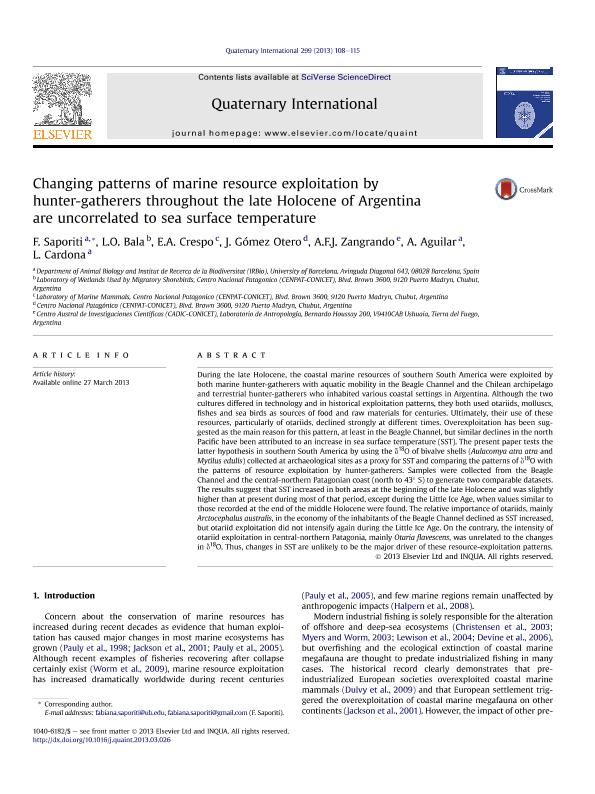Mostrar el registro sencillo del ítem
dc.contributor.author
Saporiti, F.
dc.contributor.author
Bala, Luis Oscar

dc.contributor.author
Crespo, Enrique Alberto

dc.contributor.author
Gomez Otero, Julieta

dc.contributor.author
Zangrando, Atilio Francisco Javier

dc.contributor.author
Aguilar, A.
dc.contributor.author
Cardona, L.
dc.date.available
2017-07-21T19:35:20Z
dc.date.issued
2013-06-19
dc.identifier.citation
Saporiti, F.; Bala, Luis Oscar; Crespo, Enrique Alberto; Gomez Otero, Julieta; Zangrando, Atilio Francisco Javier; et al.; Changing patterns of marine resource exploitation by hunter-gatherers throughout the late Holocene of Argentina are uncorrelated to sea surface temperature; Elsevier; Quaternary International; 299; 19-6-2013; 108-115
dc.identifier.issn
1040-6182
dc.identifier.uri
http://hdl.handle.net/11336/21113
dc.description.abstract
During the late Holocene, the coastal marine resources of southern South America were exploited by both marine hunter-gatherers with aquatic mobility in the Beagle Channel and the Chilean archipelago and terrestrial hunter-gatherers who inhabited various coastal settings in Argentina. Although the two cultures differed in technology and in historical exploitation patterns, they both used otariids, molluscs, fishes and sea birds as sources of food and raw materials for centuries. Ultimately, their use of these resources, particularly of otariids, declined strongly at different times. Overexploitation has been suggested as the main reason for this pattern, at least in the Beagle Channel, but similar declines in the north Pacific have been attributed to an increase in sea surface temperature (SST). The present paper tests the latter hypothesis in southern South America by using the δ18 O of bivalve shells (Aulacomya atra atra and Mytilus edulis) collected at archaeological sites as a proxy for SST and comparing the patterns of δ18O with the patterns of resource exploitation by hunter-gatherers. Samples were collected from the Beagle Channel and the central-northern Patagonian coast (north to 43° S) to generate two comparable datasets. The results suggest that SST increased in both areas at the beginning of the late Holocene and was slightly higher than at present during most of that period, except during the Little Ice Age, when values similar to those recorded at the end of the middle Holocene were found. The relative importance of otariids, mainly Arctocephalus australis, in the economy of the inhabitants of the Beagle Channel declined as SST increased, but otariid exploitation did not intensify again during the Little Ice Age. On the contrary, the intensity of otariid exploitation in central-northern Patagonia, mainly Otaria flavescens, was unrelated to the changes in δ18 O. Thus, changes in SST are unlikely to be the major driver of these resource-exploitation patterns.
dc.format
application/pdf
dc.language.iso
eng
dc.publisher
Elsevier

dc.rights
info:eu-repo/semantics/openAccess
dc.rights.uri
https://creativecommons.org/licenses/by-nc-sa/2.5/ar/
dc.subject
Marine Resource
dc.subject
Exploitation
dc.subject
Hunter-Gatherers
dc.subject.classification
Conservación de la Biodiversidad

dc.subject.classification
Ciencias Biológicas

dc.subject.classification
CIENCIAS NATURALES Y EXACTAS

dc.subject.classification
Arqueología

dc.subject.classification
Historia y Arqueología

dc.subject.classification
HUMANIDADES

dc.title
Changing patterns of marine resource exploitation by hunter-gatherers throughout the late Holocene of Argentina are uncorrelated to sea surface temperature
dc.type
info:eu-repo/semantics/article
dc.type
info:ar-repo/semantics/artículo
dc.type
info:eu-repo/semantics/publishedVersion
dc.date.updated
2015-06-11T18:20:43Z
dc.journal.volume
299
dc.journal.pagination
108-115
dc.journal.pais
Países Bajos

dc.journal.ciudad
Amsterdam
dc.description.fil
Fil: Saporiti, F.. Universidad de Barcelona; España
dc.description.fil
Fil: Bala, Luis Oscar. Consejo Nacional de Investigaciones Científicas y Técnicas. Centro Científico Tecnológico Conicet - Centro Nacional Patagónico; Argentina
dc.description.fil
Fil: Crespo, Enrique Alberto. Consejo Nacional de Investigaciones Científicas y Técnicas. Centro Científico Tecnológico Conicet - Centro Nacional Patagónico; Argentina
dc.description.fil
Fil: Gomez Otero, Julieta. Consejo Nacional de Investigaciones Científicas y Técnicas. Centro Científico Tecnológico Conicet - Centro Nacional Patagónico; Argentina
dc.description.fil
Fil: Zangrando, Atilio Francisco Javier. Consejo Nacional de Investigaciones Científicas y Técnicas. Centro Científico Tecnológico Conicet - Centro Nacional Patagónico; Argentina
dc.description.fil
Fil: Aguilar, A.. Universidad de Barcelona; España
dc.description.fil
Fil: Cardona, L.. Universidad de Barcelona; España
dc.journal.title
Quaternary International

dc.relation.alternativeid
info:eu-repo/semantics/altIdentifier/url/http://www.sciencedirect.com/science/article/pii/S1040618213001596
dc.relation.alternativeid
info:eu-repo/semantics/altIdentifier/doi/http://dx.doi.org/10.1016/j.quaint.2013.03.026
Archivos asociados
